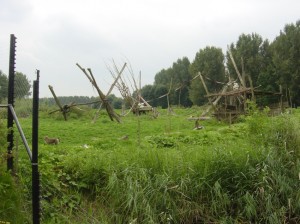Animal sanctuaries and rescue centres
While a captive wild animal industry exists, homes will inevitably be needed for the surplus and cast-offs from that industry. As zoos and circuses close; as wild animals are indiscriminately bred in captivity; as illegally-kept wild animals are confiscated or surrendered; as exotic pets are dumped as fashions change – there is an urgent need for facilities in which non-releasable captive wild animals can spend the rest of their lives.
Global Federation of Animal Sanctuaries (GFAS)
Well-run animal sanctuaries can provide a partial solution to the welfare problems associated with the captive animal industry, allowing animals in need of rescue to be cared for in adequate circumstances. Unfortunately, the word sanctuary is often misused and misunderstood. There is a need for the public to be able to differentiate between exploitative operations and legitimate animal sanctuaries. As a result, the Global Federation of Animal Sanctuaries (GFAS) was formed in 2007 by globally recognized leaders in the animal protection field with the sole purpose of strengthening and supporting the work of animal sanctuaries worldwide. GFAS does not operate animal sanctuaries, but rather helps sanctuaries to help animals. GFAS has established clear, specific standards for the humane care of various species in captive facilities and for sanctuary governance and operational issues, along with an objective and realistic independent accreditation process for animal sanctuaries. The GFAS goal in working with and assisting sanctuaries is to ensure that sanctuaries are supported, honoured, recognised and rewarded for meeting important criteria in providing care to the animals in residence, without putting unreasonable burdens on often over-extended and under-funded sanctuary operators.
The European Alliance of Rescue centres and Sanctuaries (EARS)
The European Alliance of Rescue centres and Sanctuaries (EARS) aims to be a strong and effective European network to support, promote and achieve continuous improvements in animal welfare and respect for animals, tackling the very reasons that necessitate the existence of rescue centres and sanctuaries. EARS is made up of 18 rescue centres and sanctuaries from across Europe including those from Italy, Greece, France, Germany, UK, the Netherlands, Spain, Belgium, Austria, Bulgaria and Romania.
A facility that rescues and provides shelter and care for animals that have been abused, injured, abandoned or are otherwise in need. There should be no commercial trade, no invasive or intrusive research, no unescorted public visitation or contact in wild animal sanctuaries, no breeding of non-releasable animals and no removal of wild animals for exhibition, education, or research. A sanctuary should have non-profit status and all necessary licences and permits.
Animal Sanctuary: A facility that rescues and provides shelter and care for animals that have been abused, injured, abandoned or are otherwise in need, where the welfare of each individual animal is the primary consideration in all sanctuary actions. In addition the facility should enforce a non-breeding policy and should replace animals only by way of rescue, confiscation or donation.
- Most sanctuaries and rescue centres have one strange goal in common: to put themselves out of business! They look forward to the day when their services will not be necessary.
- There is no EU-wide agreed legal definition of a sanctuary or rescue centre, this causes confusion for enforcing authorities in member countries as to what legislation can be used to protect the animals involved.
- Sanctuaries and rescue centres need to strike a balance between providing for as many animals in need as possible and maintaining the quality of life for those already in their care.
- Running a sanctuary well is an expensive business! Wild Futures’ Monkey Sanctuary in Cornwall spends £1000 per monkey on food alone each year.
GFAS, and all true sanctuaries, maintain that a sanctuary is a facility that rescues and provides shelter and care for animals that have been abused, injured, abandoned or are otherwise in need. There can be:
- No commercial trade (buying or selling)
- No invasive or intrusive research
- No unescorted public visitation or contact in wild animal sanctuaries
- No removal of wild animals for exhibition, education, or research
- No breeding (Exceptions can be made for rehabilitation and release centres engaged in a bona fide breeding-for-release program with available release sites within the state/province, conducted with specific conservation goals, in accordance with local, state/province, national, and international law and regulations. Breeding tigers in the US, for example, does not qualify for an exception.)
All too often, however, the public is misguidedly led to believe that any captive animal facility — especially those with exotic wild animals — is a sanctuary. The operators of these “pseudo-sanctuaries” prey on this misconception to buy and sell wildlife and get financial support from the unwitting public.
(From GFAS website, www.sanctuaryfederation.org)


